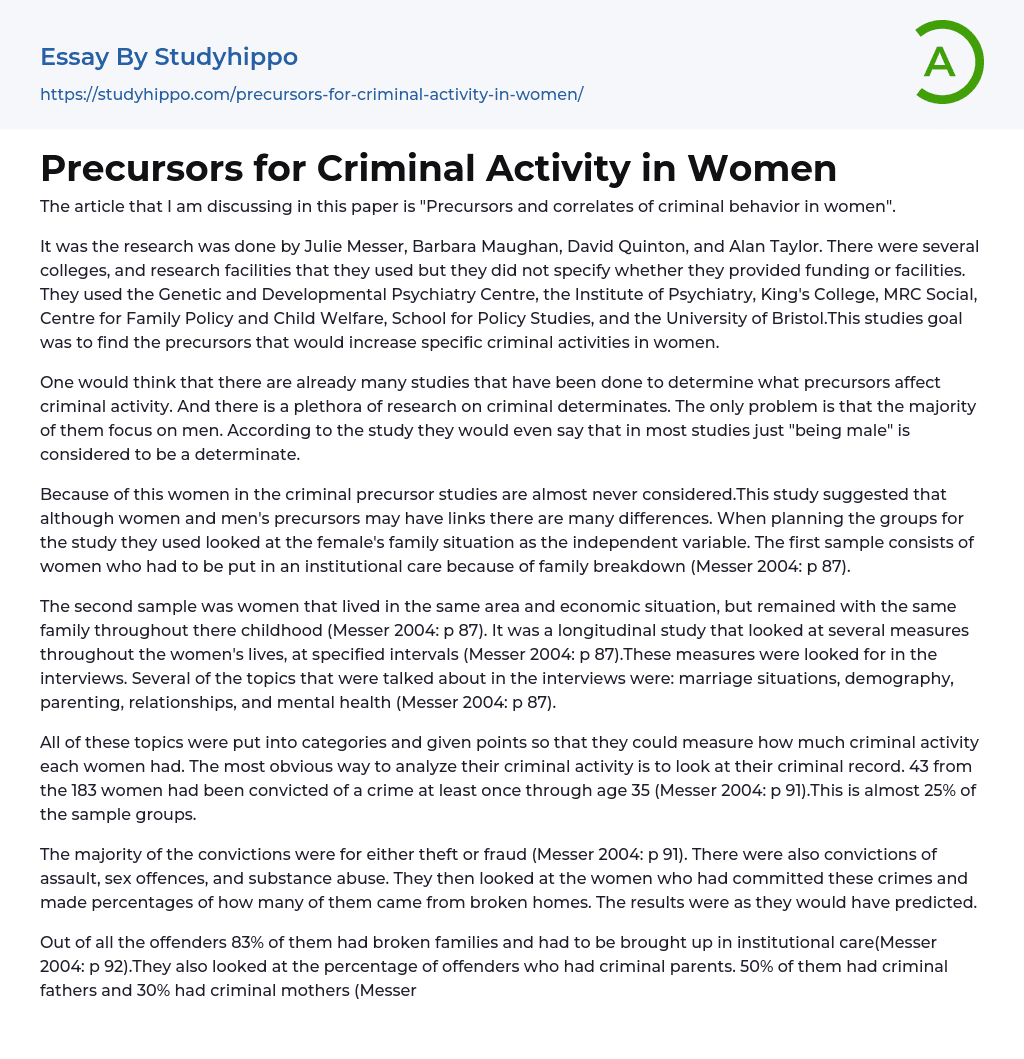The focus of my paper is on "Precursors and correlates of criminal behavior in women."
Julie Messer, Barbara Maughan, David Quinton, and Alan Taylor conducted their research at the Genetic and Developmental Psychiatry Centre, Institute of Psychiatry, King's College, MRC Social, Centre for Family Policy and Child Welfare, School for Policy Studies, and the University of Bristol. It is uncertain whether these institutions furnished financial assistance or resources. The aim of the investigation was to identify the antecedent elements that result in female criminal conduct on an individual level.
While numerous studies have investigated the factors influencing criminal behavior, most of them concentrate on men. In fact, a few studies even pinpoint "male gender" as a determining factor for criminal activity.
Although women are rarely included in studies on criminal precursors, this research revealed significant differences between male and fe
...male precursors. The study groups were determined based on the family situation of females as an independent variable. One sample included institutionalized women who experienced family breakdown (Messer 2004: p 87).
The second sample consisted of women who lived in the same area and economic circumstances and remained with the same family during their childhood (Messer 2004: p 87). This was a longitudinal study that examined various factors at specified intervals throughout the women's lives, which were assessed through interviews (Messer 2004: p 87). The interviews covered several topics including marriage, demographics, parenting, relationships, and mental health (Messer 2004: p 87).
The categorization and scoring of topics were utilized to evaluate the extent of criminal behavior in women. The analysis primarily focused on their criminal history, with Messer (2004: p 91) revealing that out of 183 women, approximately 25% (43 individuals
had been convicted of a crime before reaching the age of 35.
Messer's (2004) study revealed that the majority of convictions were linked to theft or fraud, but instances of assault, sex offenses, and substance abuse were also identified. Additionally, the research examined the backgrounds of female offenders and discovered that a substantial proportion came from disrupted families, as anticipated.
According to Messer (2004: p 92), 83% of offenders came from broken families and were raised in institutional care. In addition, 50% had criminal fathers and 30% had criminal mothers. Other factors that were analyzed included employment difficulties during late teen years (15-21) and association with deviant friends after leaving home (Messer 2004: p 93).
According to Messer (2004: p93), almost half of the offenders encountered employment difficulties during their teenage years, while 59% of them had friends who engaged in deviant behavior during these years. A surprising finding was that 58% of the offenders experienced teenage pregnancies, which is very close to the percentage of deviant friends. This suggests a potential correlation between deviant friendships and teen pregnancies. Mental health was also taken into consideration.
According to Messer's (2004: p 96) analysis, two age groups were studied in terms of their rates of substance abuse and psychiatric episodes. The first group, which consisted of teenage to mid-twenties offenders, exhibited a consistent 23% history of substance abuse. This pattern remained the same for the second group comprising individuals in their twenties to thirties. However, there was a notable increase in psychiatric episode rates from 43% in the first age group to 51% in the second group (Messer, 2004: p 96).
Individuals may have committed numerous crimes as a result of
drug or alcohol use and psychiatric episodes. Although similarities exist between these precursors in both males and females, there are also notable differences. A significant difference is the absence of early signs of anger or aggression in girls, which is a key aspect to consider when evaluating boys for potential criminal conduct. Educators can improve their predictions about possible female involvement in criminal behavior by taking these indicators into account.
Attempts can be made to stop these girls from turning into lawbreakers.
- Animal Cruelty essays
- Law Enforcement essays
- Juvenile Justice System essays
- Surveillance essays
- Forensic Science essays
- Crime Prevention essays
- Criminal Justice essays
- Criminology essays
- Drug Trafficking essays
- Juvenile Delinquency essays
- Organized Crime essays
- Penology essays
- Prison essays
- Property Crime essays
- Punishment essays
- Serial Killer essays
- Sexual Offence essays
- Victim essays
- Crime scene essays
- Punishments essays
- Charles Manson essays
- Juvenile Crime essays
- Piracy essays
- Stealing essays
- Gang essays
- Hate Crime essays
- Homicide essays
- Damages essays
- Murder essays
- Robbery essays
- Ted Bundy essays
- Prostitution essays
- Violent crime essays
- Rape essays
- Identity Theft essays
- Sexual Harassment essays
- Distracted Driving essays
- Drunk Driving essays
- Detention essays
- Sexual Assault essays
- Sexual Assault on College Campuses essays
- Cyber Crime essays
- White Collar Crime essays
- Fur essays
- Federal Bureau Of Investigation essays
- Fire Department essays
- Criminal Justice System essays
- Commitment essays
- Mass Incarceration essays
- Kill essays




